43.2 Using the MTA Web Console
The MTA Web console enables you to monitor the MTA from any location where you have access to a Web browser and the Internet. This provides substantially more flexible access than the MTA server console, which can only be accessed from the server where the MTA is running.
43.2.1 Setting Up the MTA Web Console
The default HTTP port for the MTA Web console is established during MTA installation. You can change the port number and increase security after installation.
-
In ConsoleOne, browse to and right-click the MTA object, then click .
-
Click to display the Network Address page.
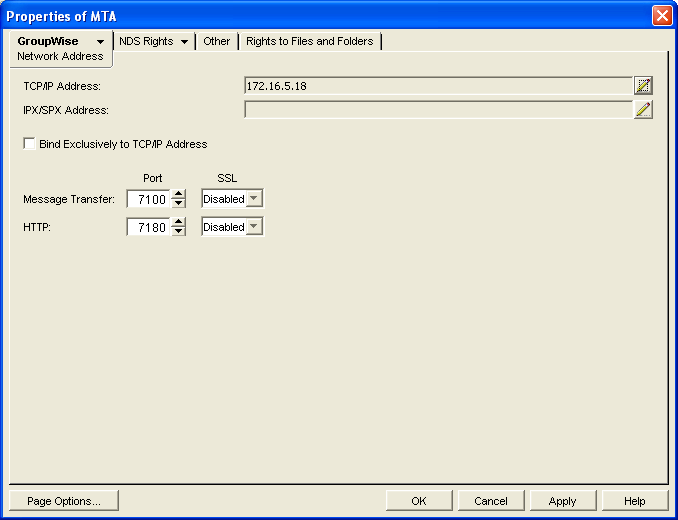
If you configured the MTA for TCP/IP links during installation, the field should display the MTA server’s network address. If it does not, follow the instructions in Using TCP/IP Links between Domains. The MTA must be configured for TCP/IP in order to provide the MTA Web console.
-
Make a note of the IP address or DNS hostname in the field. You need this information to access the MTA Web console.
The field displays the default port number of 7180.
-
If the default HTTP port number is already in use on the MTA server, specify a unique port number.
-
Make a note of the HTTP port number. You will need this information to access the MTA Web console.
-
If you want to use an SSL connection for the MTA Web console, which provides optimum security, select in the drop-down list.
For additional instructions about using SSL connections, see Section 83.2, Server Certificates and SSL Encryption.
-
Click to save your changes on the Network Address page.
If you want to limit access to the MTA Web console, you can provide a user name and password.
-
Click to display the Agent Settings page.
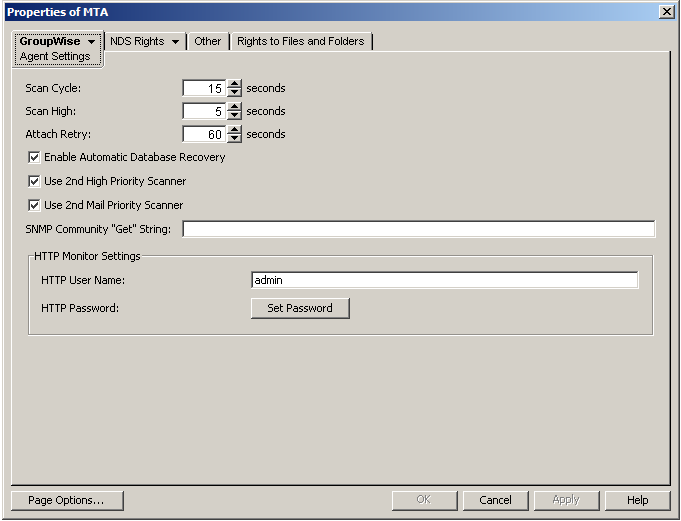
-
In the box:
-
In the field, specify a unique user name.
-
Click .
-
Type the password twice for verification.
-
Click .
Unless you are using an SSL connection, do not use an eDirectory user name and password because the information passes over the non-secure connection between your Web browser and the MTA.
For convenience, use the same user name and password for all agents that you plan to monitor from GroupWise Monitor. This saves you from having to provide the user name and password information as Monitor accesses each agent.
-
-
Click to save the MTA Web console settings.
ConsoleOne then notifies the MTA to restart so the new settings can be put into effect.
Corresponding Startup Switches: You can also use the ‑‑httpport, ‑‑httpuser, and ‑‑httppassword startup switches in the MTA startup file to enable the MTA Web console. In addition, you can use the ‑‑httprefresh switch to control how often the MTA refreshes the information provided to your Web browser.
43.2.2 Accessing the MTA Web Console
To monitor the MTA from your Web browser, view the URL where the MTA is located by supplying the network address and port number as provided in ConsoleOne. For example:
http://172.16.5.18:7100 http://172.16.5.18:7180 http://server1:7100 https://server2:7180
When viewing the MTA Web console, you can specify either the message transfer port or the HTTP port.
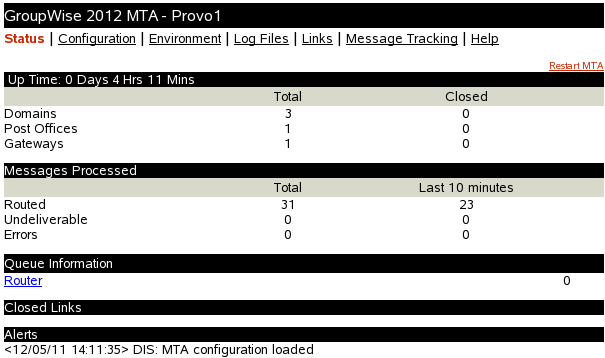
43.2.3 Monitoring the MTA from the MTA Web Console
The MTA Web console provides several pages of information to help you monitor the performance of the MTA. The title bar at the top of the MTA Web console displays the name of the MTA and its domain. Below the title bar appears the MTA Web console menu that lists the pages of information available in the MTA Web console. Online help throughout the MTA Web console helps you interpret the information being displayed and use the links provided.
Monitoring MTA Status
When you first access the MTA Web console, the Status page is displayed. Online help throughout the MTA Web console helps you interpret the information being displayed and use the links provided.

Click the link to display details about the MTA routing queue (gwinprog). You can quickly determine how many messages are awaiting processing, how large they are, and how long they have been waiting in the routing queue.
Click a closed location to display its holding queue to see how many messages are waiting for transfer.
Checking the MTA Operating System Environment
On the MTA Web console menu, click to display information about the operating system where the MTA is running.
On a Linux server, the following information is displayed:
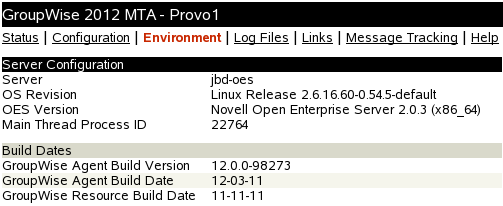
On a Windows server, the following information is displayed:
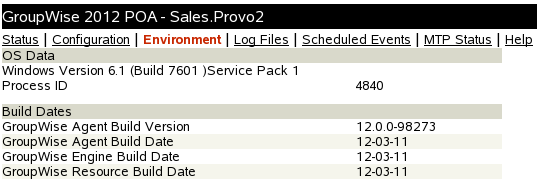
Viewing and Searching MTA Log Files
On the MTA Web console menu, click to display and search MTA log files.
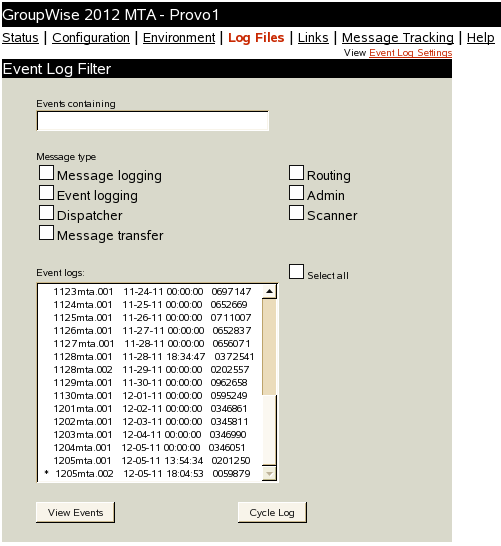
To view a particular log file, select the log file, then click .
To search all log files for a particular string, type the string in the field, select , then click . You can also manually select multiple log files to search.
In the list, you can select one or more types of MTA processing to search for:
-
Message Logging (MLG): The message logging threads write information into the message log file if message logging has been turned on. See Section 42.4.2, Enabling MTA Message Logging.
-
Event Logging (LOG): The event logging thread writes information into the event log files that you can search on this page. See Section 43.3, Using MTA Log Files.
-
Dispatcher (DIS): The dispatcher thread starts other MTA threads as needed to meet the demands being put on the MTA at any given time.
-
Message Transfer (MTP): The message transfer threads communicate with other MTAs and with POAs in the local domain to transfer messages to domains and post offices to which the local MTA is linked by way of TCP/IP. See Using TCP/IP Links between Domains and Using TCP/IP Links between a Domain and its Post Offices.
-
Routing (RTR): The router threads process messages in the routing queue and prepare them for transfer to the next hop in the link path to their destinations. See Section 44.3, Optimizing the Routing Queue.
-
Admin (ADM): The admin thread updates the domain database (wpdomain.db) whenever administrative information changes. See MTA Admin Thread Status Box.
-
Scanner (SCA): The scanner threads check for incoming messages when UNC or mapped links are in use. See Section 44.2.3, Adjusting the Number of MTA Scanner Threads for the Domain and Post Offices.
The results of the search are displayed on a separate page that can be printed.
Monitoring the Routing Queue
On the MTA Web console menu, click , then click to display the contents of the routing queue. Typically, no message files are waiting unless the MTA is down or backlogged.
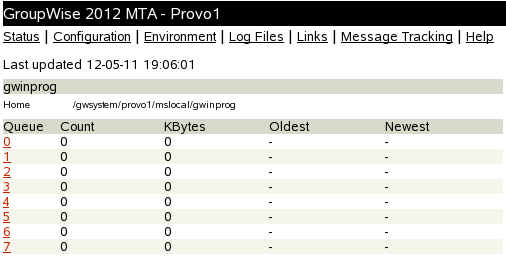
You can click any queue to view the message files it contains.
Monitoring Links
On the MTA Web console menu, click to monitor the direct links between the MTA and other locations.
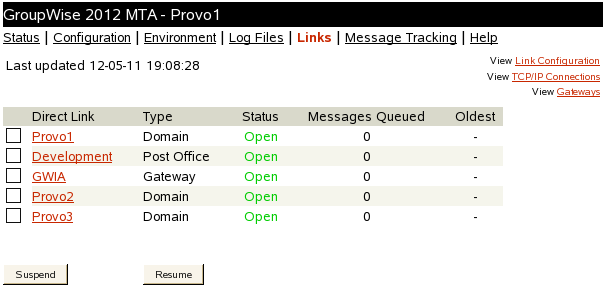
Click a location to view its holding queue. Click to determine the address of each location and access the agent Web consoles of other domains and of post offices that belong to the local domain. Click to view incoming and outgoing TCP/IP links. Click to restrict the list to just gateways.
Tracking Messages
Before you can track messages at the MTA Web console, you must enable message logging for MTAs throughout your system. See Section 42.4.2, Enabling MTA Message Logging. When you enable MTA message logging, the MTA stores data about GroupWise message traffic as it processes messages. The stored data is then available for use from the MTA Web console.
To track a specific message, have the sender check the Sent Item Properties for the message in the GroupWise client. The field displays the message ID of the message; for example, 3AD5EDEB.31D : 3 : 12763. To track all messages sent by a particular user, make a note of the user’s GroupWise user ID.
On the MTA Web console menu, click .
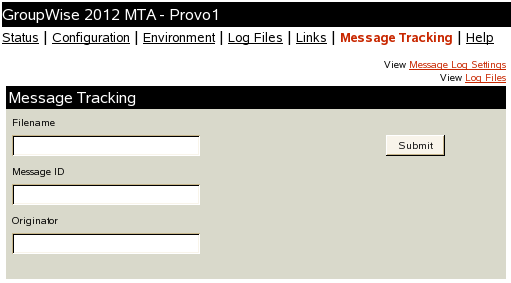
Fill in one of the fields, depending on what you want to track, then click . The results of the search are displayed on a separate page which can be printed.
43.2.4 Controlling the MTA from the MTA Web Console
At the MTA Web console, you can change some MTA log settings for the current MTA session. You can also stop and start some specific MTA threads.
IMPORTANT:In order to control the MTA from the MTA Web console, you must set up authentication for the MTA Web console, as described in Section 43.2.1, Setting Up the MTA Web Console.
Changing MTA Configuration Settings
On the MTA Web console menu, click . Online help on the Configuration page helps you interpret the configuration information being displayed.
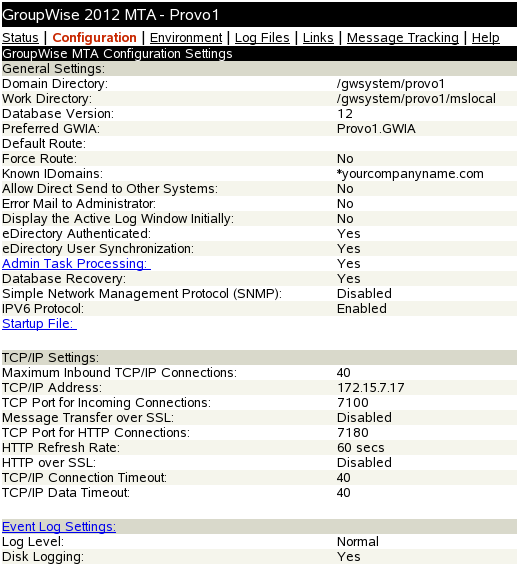
Click the heading to change the MTA log settings for the current MTA session.
Controlling the MTA Admin Thread
On the Configuration page, click .
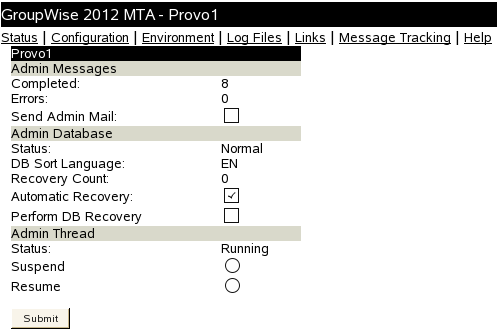
Modify the functioning of the MTA admin thread as needed, then click . The changes remain in effect for the current MTA session.
Controlling Links to Other Locations
On the MTA Web console menu, click .

Select one or more locations, then click or as needed.